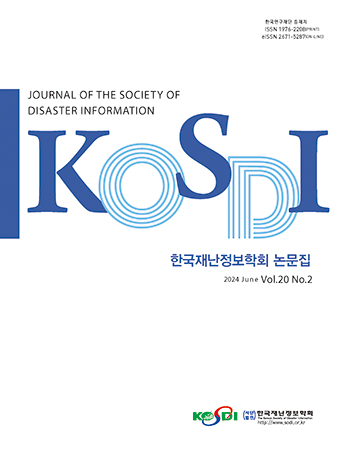Original Article
Abstract
References
Information
Purpose: This study aims to come up with improvement measures to improve the effectiveness of child safety measures. Method: The current status of child safety accidents was investigated and implications were deduced by analyzing major child safety measures by government department in the past. In addition, a perception survey was conducted on 1,000 people including children, guardians, and children's facility workers who are subject to child safety policies. Result: Regarding the safety of children's living space(environment), 35.3% of guardians answered that more than 1/3 of them were not safe. Both guardians(95.3%) and children's facility workers(89%) answered that there was the highest risk of 'traffic accidents', and the second risk factor was parents(carelessness of workers at children's facilities) and children's facility workers(careless of guardians at home). Looking at the risks by place, “road and sidewalk” was the most dangerous place and for child safety, guardians(64.3%) and workers(78.3%) both said that the role of “parent” is the most important. For improvements to prevent child safety accidents, the response rate of “strengthening safety management of road traffic facilities” is the most necessary with 75.8% for guardians and 65% for child use facilities. Conclusion: The reinforcement measures to strengthen the effectiveness of child safety measures are as follows. First, in order to ensure the continuity of child safety measures, it should be operated effectively so that those subject to the establishment of the Comprehensive Plan for Child Safety, which took effect in August 2022, can feel it. Second, in order to improve the sensitivity of children's policy targets, promotion measures that take into account the characteristics of each child safety field should be continuously strengthened. Third, it is necessary to expand safety infrastructure for each field to secure child safety. Fourth, it is necessary to strengthen safety education that can ensure safety for children themselves and to come up with detailed measures to make safety education for parents(guardians) mandatory.
연구목적: 본 연구는 어린이 안전대책의 실효성을 향상시키기 위한 개선방안을 마련하고자 한다. 연구방법: 어린이 안전사고 발생 현황에 대하여 조사하였고 과거 정부 부처의 주요 어린이 안전대책을 분석하여 시사점을 도출하였다. 또한 어린이안전 정책 대상자인 어린이, 보호자, 어린이이용시설 종사자 1,000명을 대상으로 인식조사를 실시하여 향후 어린이 안전대책의 실효성 방안을 제시하였다. 연구결과: 어린이 생활공간(환경)의 안전도에 대해 보호자는 35.3%로 1/3 이상이 안전하지 않다고 응답하였다. 또한 보호자(95.3%), 어린이이용시설 종사자(89%) 모두 ‘교통사고’에 대하여 위험성이 가장 높다고 응답하였고 2번째 위험 요인은 부모(어린이이용시설 종사자 부주의)와 어린이이용시설 종사자(가정 내 보호자 부주의)가 상반된 의견을 보였다. 장소별 위험성을 살펴보면 ‘도로와 인도’를 가장 위험한 장소로 응답하였고 어린이안전을 위해 부모(64.3%) 및 종사자(78.3%) 모두 ‘부모’역할이 가장 중요하다고 응답하였다. 어린이 안전사고 예방을 위한 개선사항은 ‘도로교통 시설물 안전관리 강화’ 응답률이 보호자 75.8%, 어린이이용시설 종사자 65%로 가장 필요하다고 응답하였다. 결론: 어린이 안전대책의 실효성을 강화하기 위한 방안은 다음과 같다. 첫째, 어린이 안전대책의 연속성을 확보하기 위해 2022년 8월부터 시행된 「어린이안전 종합계획」을 수립하고 정책 대상자가 체감할 수 있도록 실효성 있게 운영해야 한다. 둘째, 어린이 정책 대상자의 체감도를 향상시키기 위해 어린이안전 분야별 특성을 고려한 추진대책을 지속적으로 강화해야 한다. 셋째, 어린이 안전성 확보를 위한 분야별 안전인프라를 확충해야 한다. 넷째, 어린이 스스로가 안전성을 확보할 수 있는 안전교육을 강화하고 부모(보호자) 안전교육이 의무화될 수 있는 세부적인 대책 마련해야 한다.
- Korea Consumer Agency (2023). Analysis of Child Safety Accident Trends in 2022. Eumseong.
- Kwon, J.S., Lee, H.J., Shin, E.H., Park, S.S. (2019). "The effect of community mapping application development and application on the safety consciousness of elementary and middle schools." Journal of the Korea Society of Disaster Information, Vol. 15, No. 3, pp. 323-338.
- Korea Institute of Disaster & Safety (2021). A Study on the Establishment of the 1st Comprehensive Child Safety Plan. Ministry of the Interior and Safety, Sejong.
- Son, M.H., Kweo, I.R., Jung, T.H., Lee, H.J. (2021). "Demonstration of disaster information and evacuation support model for the safety vulnerable groups." Journal of the Korea Society of Disaster Information, Vol. 17, No. 3, pp. 465-486.
- Statistic Korea KOSIS (2023). Cause of Death(104 items)․Number of deaths by gender․age(5 years old), death rate(under 15 years old). Daejeon.
- Publisher :The Korean Society of Disaster Information
- Publisher(Ko) :한국재난정보학회
- Journal Title :Journal of the Society of Disaster Information
- Journal Title(Ko) :한국재난정보학회논문집
- Volume : 19
- No :4
- Pages :869-881
- DOI :https://doi.org/10.15683/kosdi.2023.12.31.869




 Journal of the Society of Disaster Information
Journal of the Society of Disaster Information







